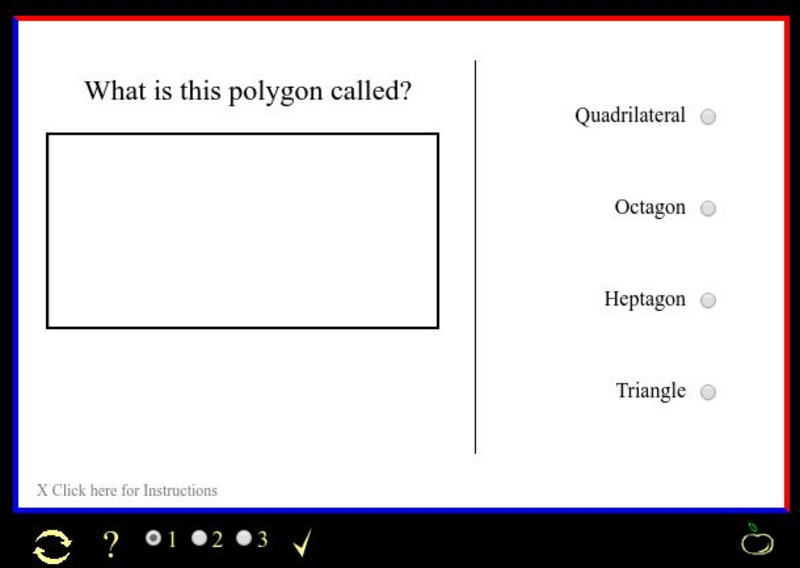Hi, what do you want to do?
Curated OER
Applying Proportionality in Scale Drawings
Sixth graders examine a blue print and discuss the reasoning behind using blue prints. In this proportionality lesson, students collaborate with their teammates to create a scale drawing. Once that is complete, 6th graders write a...
Curated OER
The Stained Glass Window
Middle schoolers use centimeter rulers and the attached worksheet containing a scale drawing of a stained glass window. The actual measurements of the stained glass window are given, and students are asked to find the actual measurement...
Curated OER
Shapetown
Students identify basic geometric shapes. In this geometry lesson, students read the book Shapetown and identify the various shapes from the story. Students are given a sheet and draw part of a town using only shapes.
Curated OER
Fractions of a Set
Third graders use fractions to describe part of a set. In this fractions lesson, 3rd graders are introduced to fractions through a book and use pattern blocks to describe a fraction as a part of a set. This lesson includes a scripted...
Curated OER
Fractions Describe Parts of a Whole
Third graders represent fractions as part of a whole. In this fractions instructional activity, 3rd graders use manipulatives to show how a fraction is a part of a whole. This instructional activity includes individual practice and an...
Curated OER
What's Your Design?
Sixth grade students: design a stained glass window, submitting their initial plan detailing the measurements of all lines and angles. Seventh grade students: create a scale drawing of their own geometric family of four members.
Curated OER
Finding the Area of a Parallelogram with Translations
Students calculate the area of parallelograms. In this geometry lesson, students identify properties of parallelograms and use to to solve problems. They create polygons using Cabri software.
Curated OER
Opening A Cube
Fifth graders investigate mathematical concepts related to the construction of a three dimensional cube. They construct the cube from two dimensional patterns and compute the surface area. Students also define the faces, edges, and...
Curated OER
Checking County Numbers
Students use their county's information page to gather information about their community. Using the information, they create graphs from the tables provided and interpret the data. They write a paragraph showing their interpretation of...
National Council of Teachers of Mathematics
Nctm: Illuminations: Cutting Corners
Students will use their knowledge of plane figure attributes to create and view shapes by cutting and rotating shapes to stimulate discussions on names and attributes of various shapes they do not regularly encounter.
CK-12 Foundation
Ck 12: Elem Math: Classify Objects as Rectangles, Squares, Circles, or Triangles
[Free Registration/Login may be required to access all resource tools.] Students watch a video and attempt practice problems on classifying rectangles, squares, circles and triangles.
CK-12 Foundation
Ck 12: Elem Math: Classify Objects as Rectangles, Squares, Circles, or Triangles
[Free Registration/Login may be required to access all resource tools.] Students practice classifying various two dimensional shapes as rectangles, squares, circles or triangles.
CK-12 Foundation
Ck 12: Elem Math: Classifying Real Life Objects as Basic 2 D Shapes
[Free Registration/Login may be required to access all resource tools.] The video describes how to classify a real-world object as a circle, triangle, square or rectangle. The video is followed by additional practice problems.
Khan Academy
Khan Academy: Classify Shapes by Line and Angle Types
Classify shapes based on pictures or attributes, such as angle types and side-lengths. Students receive immediate feedback and have the opportunity to try questions repeatedly, watch a video or receive hints.
GeoGebra
Geogebra: Copy of Classify Two Dimensional Figures
User will drag the vertices of the quadrilaterals to decide on the best possible classification.
Mr. Martini's Classroom
Mr. Martini's Classroom: Classifying Polygons and Finding Perimeters
Assess learning of polygons and perimeters with this interactive multiple choice practice and quiz activity. Click the question mark for hints.
Khan Academy
Khan Academy: Practice: Classify Shapes by Line and Angle Types
Look at the properties of 2D shapes to see which shapes can belong to the same group. Includes hints.
PBS
Pbs Mathline Lesson: Geometry, It's a Perfect Fit [Pdf]
This two-part geometry lesson plan has students identify, describe, and classify two-dimensional shapes. Students engage in hands-on activities including identifying shapes in the classroom, creating patterns with shapes, identifying...
CK-12 Foundation
Ck 12: Geometry: Quadrilateral Classification
[Free Registration/Login may be required to access all resource tools.] This concept teaches students to classify quadrilaterals in the coordinate plane.
Alabama Learning Exchange
Alex: What Do We Have in Common?
This inquiry lesson explores the definitions of quadrilaterals and the properties of the diagonals of quadrilaterals to classify quadrilaterals. Students will work cooperatively to justify conclusions. This lesson plan was created by...
Math Is Fun
Math Is Fun: Regular 2 D Shapes
This tutorial provides illustrations for regular 2-D shapes as well as a definition for polygons and for regular polygons.
Alabama Learning Exchange
Alex: Quadrilaterals
This is an inquiry lesson used to review Algebra 1 objectives by applying them to geometry concepts. Students explore the properties of quadrilaterals and classify them by definition. This lesson can be use in geometry classes. Students...
University of Regina (Canada)
University of Regina: Math Central: Lesson: Mr. Z's 5 Minute Game of Geometric Pandemonium
Students make a series of geometric drawings of points, obtuse angles, rays, polygons, and the like. Each child is given one but not allowed to show anyone else. The drawing is then taped to the back of the child in front of them. The...
NumberNut
Number Nut: Shapes, Symbols and Colors: Two Dimensional Shapes
Describes, with illustrations, the basic two-dimensional shapes students will encounter in elementary Math.



























